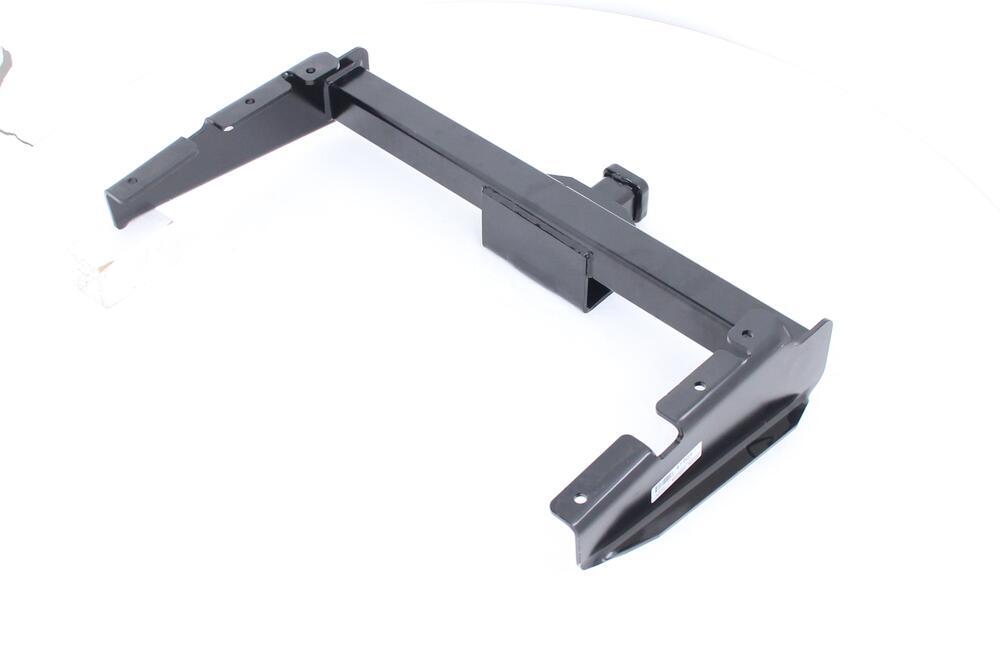You are using an out of date browser. It may not display this or other websites correctly.
You should upgrade or use an alternative browser.
You should upgrade or use an alternative browser.
Tow Hitch Rating and Recoveries
- Thread starter cs0430
- Start date
Herbie
Rendezvous Conspirator
Tow ratings are based on a lot of factors - brakes, suspension, transmission, etc. For a recovery, you aren't towing so much as doing short term pulling, so in that regard you're in better shape.
On the other hand, towing assumes minimal rolling resistance of the towed vehicle, whereas recovery is typically pulling against resistance. If you're recovering via the tow hitch, I'm not entirely sure how you'd calculate the actual "pull" rating of the hitch.
On the other hand, towing assumes minimal rolling resistance of the towed vehicle, whereas recovery is typically pulling against resistance. If you're recovering via the tow hitch, I'm not entirely sure how you'd calculate the actual "pull" rating of the hitch.
comptiger5000
Adventurer
The hitch does have to handle the stress of hitting a pothole that jerks the trailer around while pulling it up a mountain at WOT though. And the hitch itself (although not necessarily its attachment point to the vehicle) is often rated for more than the vehicle's tow rating.
For most recoveries, a solid hitch is generally going to be strong enough. It's often stronger than the mounts on stock tow hooks, etc.
For most recoveries, a solid hitch is generally going to be strong enough. It's often stronger than the mounts on stock tow hooks, etc.
Ducky's Dad
Explorer
Just don't do anything silly, like taking a running start with a tow strap. If you must use a tow strap, keep it under steady tension and pull slowly. You will be better off with a jerk strap for recoveries, gives you better ability to recover another vehicle with less stress on your vehicle.
Last edited:
comptiger5000
Adventurer
FWIW, the class IV hitch on my Jeep (ZJ) didn't blink an eye at a slight running start with a recovery strap (stretchy, but not as stretchy as one of those kinetic ropes) with a bit over 12k lbs of F-350 + gooseneck trailer on the other end in some muddy grass. I gave the hitch and the unibody where it mounts a good inspection after that, no signs of cracking, bending or other stress damage.
Wh1t3nukle
I gotz dis
Pretty much what Herbie said regarding the basis of the tow rating value.
An actual dead pull rating would be based on the hitch pin and or the bolts attaching hitch frame to vehicle. Run tow strap loop into receiver with pin thru it. That pin, size depends on class, will be loaded in double shear. Bolts holding to frame will load in tension and shear.
In general, strap another vehicle that is no bigger than yourself. Many other factors play into that like conditions and experience at hand.
Lastly, don't ever use the ball on the hitch. They snap and do kill.
Here's video of snow wheeling with big trucks. See example at 3:40 seconds as I'm strapping out a megacab diesel.
https://youtu.be/1uFHzCyAV-g
An actual dead pull rating would be based on the hitch pin and or the bolts attaching hitch frame to vehicle. Run tow strap loop into receiver with pin thru it. That pin, size depends on class, will be loaded in double shear. Bolts holding to frame will load in tension and shear.
In general, strap another vehicle that is no bigger than yourself. Many other factors play into that like conditions and experience at hand.
Lastly, don't ever use the ball on the hitch. They snap and do kill.
Here's video of snow wheeling with big trucks. See example at 3:40 seconds as I'm strapping out a megacab diesel.
https://youtu.be/1uFHzCyAV-g
MOguy
Explorer
if your 4Runner receiver is like mine it is bolted to a cross bar of the framedand not a true load bearing hitch. I would be very careful doing any pulls especially side pulls.Might be a dumb question but here goes:
The tow rating on my 4Runner is 4700lbs. Does that mean if I tried (using a recovery strap) to recover a vehicle that weighs 5000lbs I would risk damaging my 4R?
Last edited:
comptiger5000
Adventurer
if your 4Runner receiver is like mine it is bolted to a cross bar of the framedand not a true load bearing hitch. I would be very careful doing any pulls especially side pulls.
What's the thing rated to tow? If it's strong enough to pull any decent size trailer, it'll be fine. You'd be amazed how much load can get put on a hitch when you hit a bump in the road while accelerating up a highway on-ramp.
MOguy
Explorer
What's the thing rated to tow? If it's strong enough to pull any decent size trailer, it'll be fine. You'd be amazed how much load can get put on a hitch when you hit a bump in the road while accelerating up a highway on-ramp.
I understand what you are saying but i dont think you understand what I am saying., I would not recommend relying on a recover point that is bolted to a frame cross member. The previous 4runner came with the hitch reciever mounted 2 ways. The OPs 4 runners has a 4700 lb rating it is mounted like mine, bolted to a frame crossmember.
One way is bolted to the cross member, the V6 with a 5k rating. This is how it is on newer 4runners, but with a 4700lb rating, With the previous 4runner you could get a V8 with a 7k plus towing rating. The 7k receiver was a true weight disturbing hitch and not available on the newer 4runners. The 5k or 4700lb version is not much more than a receiver mounted to a heavy duty bumper. His is fine for towing a 4700lb or lighter trailer down the highway but may not be a suitable recovery point for offroad use.
OP you have an expensive and very nice vehicle. It is worth spending a few more dollars and getting a suitable recovery point both front and rear.
Last edited:
Wh1t3nukle
I gotz dis
Thanks everyone. I do have one of the "stretchy" type straps. I imagined the limitations would be mostly the shear strength of the bolts used to attach the tow hitch to the frame.
Fortunately, there is no imagination neccessary. It's mechanical/structural engineering. FWIW, it's a daily exercise to size structures, their joints, inclusive of the bolts (size/number/thread/type). If you use a stretchy strap (to be clear post up what brand you're referring to), then ONLY use 1 in the pull. Do not link up 2+ especially with metal Drings. My earlier post I prefaced with "dead" pull to imply a static strap. Minimal stretch as the reference. When you get into dynamic, bungee cord like, there are other issues to be concerned about....like if the attachment point on the vehicle can handle the load, which would be GREATER compared to a static pull.
if your 4Runner receiver is like mine it is bolted to a cross bar of the framedand not a true load bearing hitch. I would be very careful doing any pulls especially side pulls.
So, what is an example of the hitch being load bearing in this context....? A cross bar (crossmember) rigidly connected to the frame is only an issue if it's not sized properly. It is in fact load bearing as that is the load path from hitch to the cross bar to the frame (going by your example). Are you saying the hitch is ONLY attached to this cross bar, rather then BOTH cross bar and frame?
What's the thing rated to tow? If it's strong enough to pull any decent size trailer, it'll be fine. You'd be amazed how much load can get put on a hitch when you hit a bump in the road while accelerating up a highway on-ramp.
The weight rating is not solely based on the size and attachment methods to the vehicle. it is also the suspension and drivetrain (transmission and axle gear ratio). The load of a trailer hitting a bump in a road are far below the magnitudes of recovery that we're discussing. Yet, it's still fair to use the tow rating as an equivalent to weight of vehicle being extracted...meaning MAXIMUM. Experience at hand plays into the rest of the situation as there are no absolutes with circumstances (terrain, position, weather, rigs, etc.).
MOguy
Explorer
So, what is an example of the hitch being load bearing in this context....? A cross bar (crossmember) rigidly connected to the frame is only an issue if it's not sized properly. It is in fact load bearing as that is the load path from hitch to the cross bar to the frame (going by your example). Are you saying the hitch is ONLY attached to this cross bar, rather then BOTH cross bar and frame?
This is the hitch receiver the OP has, it only attaches to one small area on a cross bar:

This would be a hitch receiver designed to carry a heavier load. It attaches to far more of an area than the one above. This helps to distribute the weight better.

comptiger5000
Adventurer
:Wow1: Wow... I'd consider that hitch to be decorative, much like a bumper hitch. You couldn't pay me to ever attach a trailer or another vehicle to it!
MOguy
Explorer
:Wow1: Wow... I'd consider that hitch to be decorative, much like a bumper hitch. You couldn't pay me to ever attach a trailer or another vehicle to it!
I have been towing a camper that weigh about 2500-3500 lbs empty for years with my 4runner. Mine is an 04 with the V6 and that style hitch that the newer 4Runner has. My 4 runner has been an excellent tow vehicle for trailers in that range. I can get about 14mpg towing, it smooth and in control. Power, even with the V6 is more than adequate. Previous to the 4 Runner I had a Grand Cherokee that had the same weight limit for towing but it was a horrid POS when it came to towing. It got 9mpg, and unless I was on a perfect road I wasn't comfortable going much over 60mph when towing with the Grand.
As far as a recover point, noting I would use. For a simple straight pull and not stuck real bad maybe.
I do check my sub frame and hitch periodically. It has not come loose and shows no signs of fatigue. I trust if for my application.
Similar threads
- Replies
- 0
- Views
- 710
- Replies
- 21
- Views
- 4K
- Replies
- 8
- Views
- 2K
- Replies
- 21
- Views
- 3K
- Replies
- 15
- Views
- 5K
